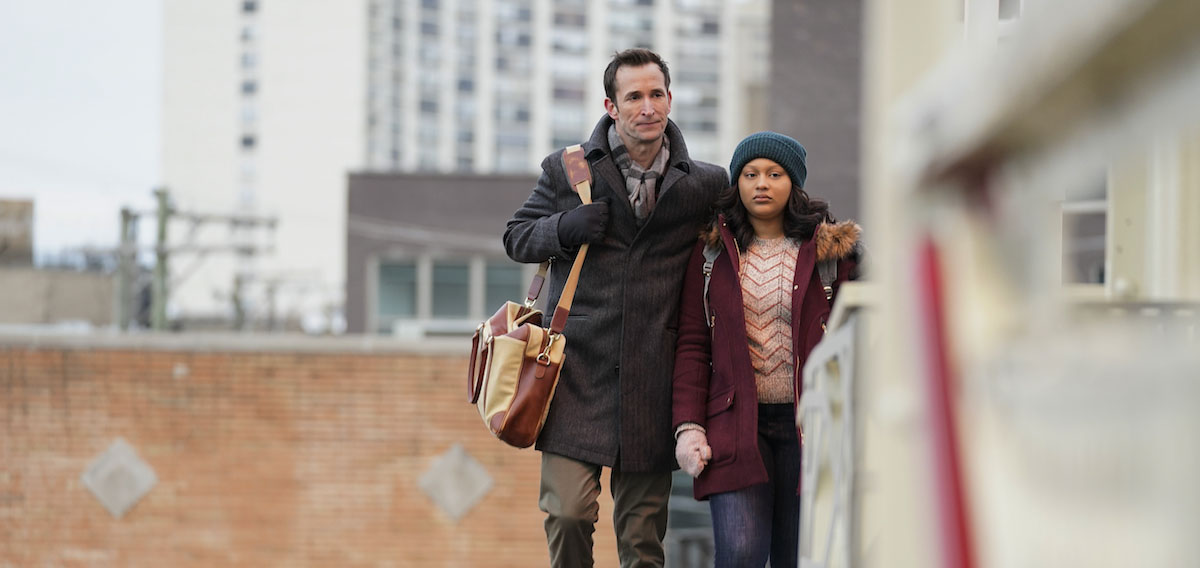CBS TV’s new drama, The Red Line, shot by Kira Kelly, visualizes the impact of a police shooting on three different American families.
by Pauline Rogers
Bringing their play, A Twist of Water, to an episodic series was an exciting challenge for writers Caitlin Parrish and Erica Weiss. The four-character story takes place over a month’s time and is focused on a gay white father and his adopted African-American daughter in Chicago, attempting to rebuild their lives after the death – from a car accident – of the man’s husband.
The pilot and subsequent eight-part series based on the play, led by Executive Producers Ava DuVernay and Greg Berlanti, offered Parrish and Weiss the chance to “rethink the circumstances around the husband’s death in the context of a more relevant national conversation on race and police violence. We could expand the story to include all three families, and the larger picture of Chicago’s divisions and connections in the present day,” the pair explained. The connecting thread and subsequent title of the series was the city’s famous Red Line train.
Most notably, Weiss explains, “the inciting death of Harrison Brennan went from offstage to onscreen. And, the circumstances changed from a car crash to a police shooting, which brought a whole new character, Officer Paul Evans, into the story. Rather than meeting Tia Young [the daughter] at the end of the play, we see her family’s story unfold from the start.”
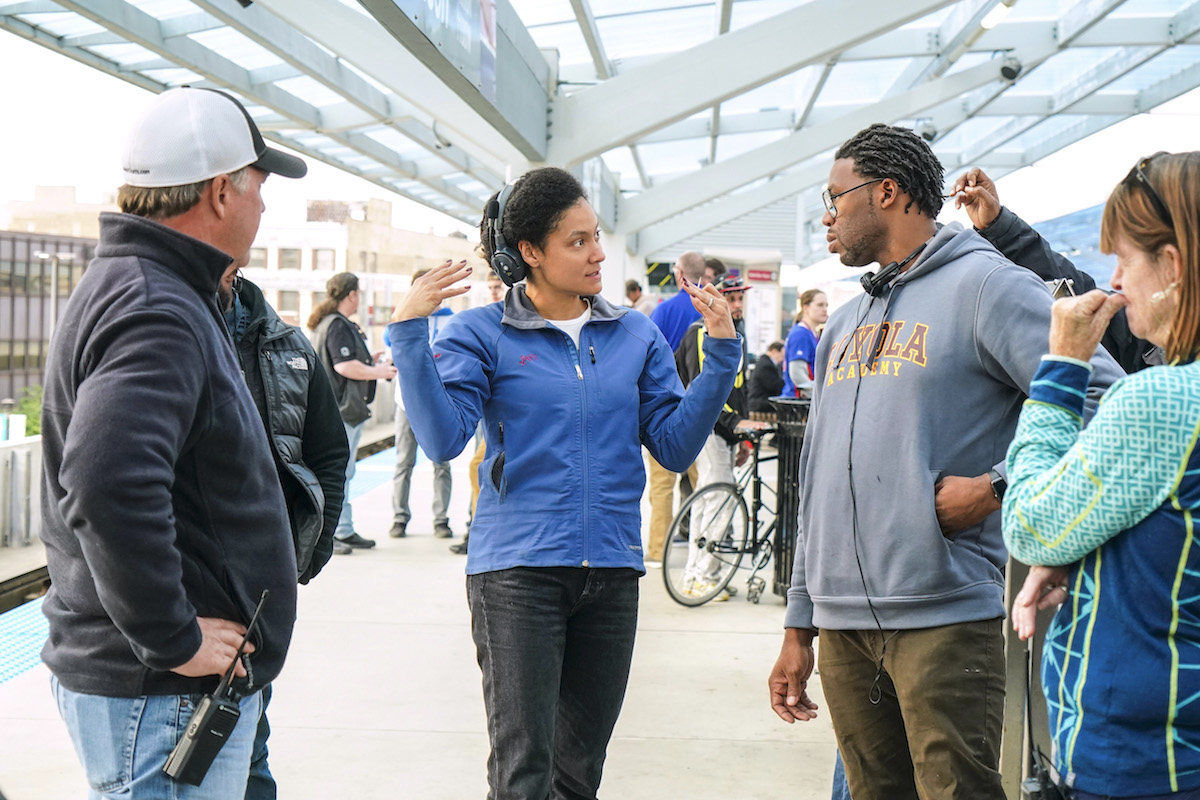
For the pilot, the two turned to Director Victoria Mahoney and Cinematographer Manuel Billeter to create a look that was “simple and elegant, without too many flourishes but with a lushness and palate that still made it stand out visually from other network dramas,” Parrish explains. “When we went to series with Cinematographer Kira Kelly and Producing Director Kevin Hooks, a more complete vocabulary for the camera was developed,” Weiss adds.
“When I came in, two days before the camera and prep, Kira had already chosen her package,” explains 1stAC Jason Bonner. “Alexa Minis with Panavision PVintage lenses. We decided not to use filtration, just ND3s and grads to shoot as close to wide open as possible.”
“Kira chose detuned Panavision Primos to flesh out the focal length range of the PVintage,” adds DIT John Waterman. They also used Panavised Angénieux and detuned Primo zoom lenses for exterior work. “The PVintage primes [which are re-housed UltraSpeeds] and the detuned Primos gave us some challenges,” Waterman notes. “The color cast of the lenses varied throughout the set, and even from shot to shot, based on the flaring and lighting kick angle.”
Waterman set Kelly’s intended look with CDL adjustments and captured reference grabs for every shot and actor position. He employed a custom Wi-Fi network for camera control on his cart that gave Kelly and him the ability to tunnel into any camera at a moment’s notice and change any setting. “We could use this remote-control ability of each camera’s EI [Exposure Index] to get a quick half-stop exposure adjustment without changing the camera’s iris or depth-of-field,” the DIT adds.
Digital loader Drew Fulton handled all of the media, downloading, and shuttle drives.“On a television schedule it’s so important to maintain the speed of setups,” Waterman continues. “Working with a digital loader, I was able to devote 100 percent of my time to working with Kira and managing the cameras.”
Kelly says she played with a lot of color contrast on set, “and [Company 3 colorist] Dave Hussey was really able to bring that out in the final grade,” she offers. “We were also able to highlight the visual differences in each of the three storylines. I was so pleased to be able to work with an artist like Dave, who does such beautiful work, but can do it at the pace TV demands.”
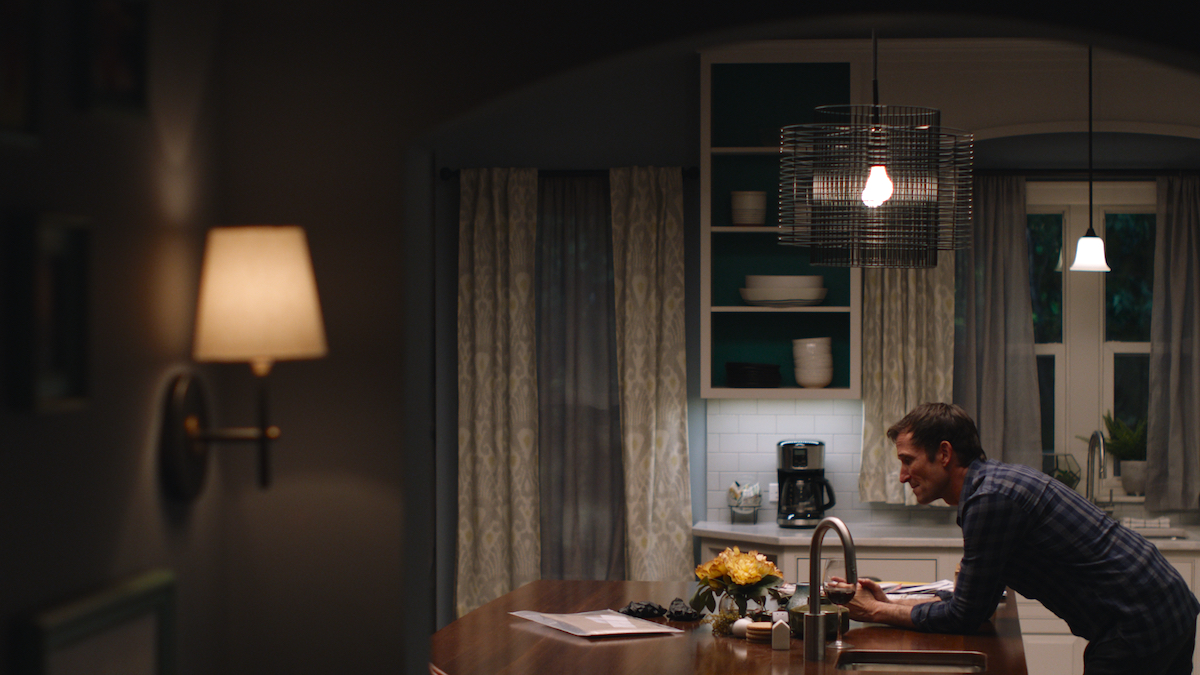
Once the workflow was set, Kelly and Hooks created a different look for each family impacted by the shooting. “We wanted viewers to feel the Calders being immobilized by grief,” Kelly explains. “The Paul Evans story became handheld, emphasizing that he’s unstable, never at peace. And the Young family, alive and vibrant, showed hope and possibility.”
To emphasize the grief of Daniel Calder (Noah Wylie) and his daughter, Jira Calder-Brennan (Aliyah Royale), the decision was made to never move the camera, aka “Calder Rules,” which, Kelly says, created some interesting frames.
“If someone is walking toward the camera,” she describes, “you have to frame them in such a way that the frame works for their rear position and their closer position without any panning and tilting during their walk. We also maintained as much negative space as possible. I wanted the compositions to show that someone, and something, was missing from their lives. That the emptiness was oppressive.”
Adds A-camera operator/2ndUnit DP Scott Thiele: “Noah’s willingness to embrace Kira’s vision was instrumental in making the whole strategy viable. We would watch a rehearsal, Kira would have the finder with a short zoom on it, searching for the one frame that would provide the setting and space for all of Noah’s actions, often riding the very edge of the frame.”
To make sure they didn’t miss the action, the team would put long runs of tape on the ground so that the actors could sight the edge of the camera frame. “We tried to use strong architectural cues and lines to highlight the weight of the family situation, often relegating the characters to the extreme bottom or corners of the frame,” Thiele says.
Not being able to adjust the frame posed some challenges for B-camera/Steadicam operator Blaine Baker. “I often did these shots on a 125- or 150-millimeter lens,” he recounts. “Not a lot of wiggle room for adjustment. But ultimately,” he admits, “these were the most beautiful and unique shots that we were able to create for the show.”
“Many of the Calder scenes were day interiors at a school,” adds Gaffer Addae Shelby. “We bounced HMIs into some 12-by-12 or 12-by-20 ultra bounces. We always had two M90s and one 18K Arrimax with an extra layer 12-by-12 diffusion that would work outside when the windows were completely off camera. Inside, we used smaller LED units like S60 SkyPanels and Freestyle 31s through an 8-by-8 diffusion frame. Kira also asked to have overhead tungsten fluorescent fixtures installed and would switch them on or off to taste.”
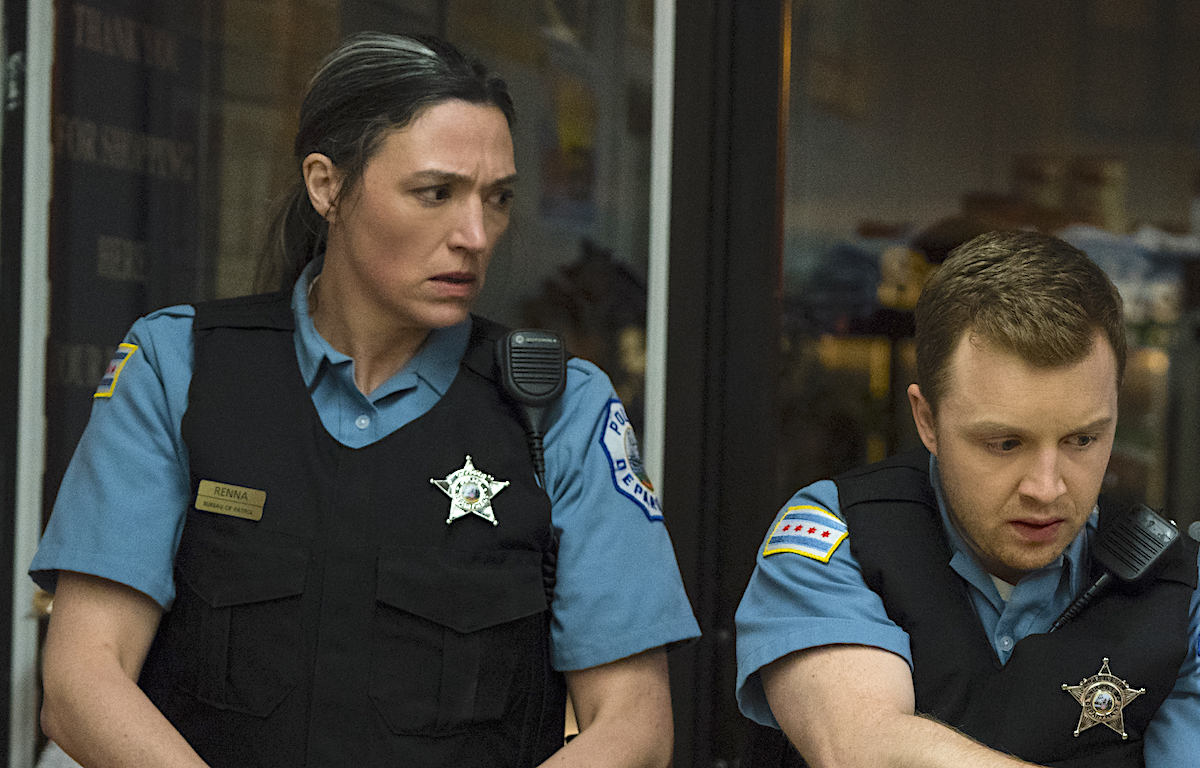
Officer Paul Evans’ storyline was always shot handheld. “Paul is a very unstable character, and never at peace,” Kelly offers. “I love that his frames show this. He was always composed in a very stacked frame, he was squeezed.”
“[Evans’] story centers on the shame, guilt, and denial of his role in the death of an innocent man,” Thiele adds. “As he’s pulled between his human decency and desire for the survival of his career, he becomes swallowed up in the frenzy. Our handheld was claustrophobic with little headroom, and on the longer end of the lens to compress his world.”
Much of Evans’ story was shot in his home and in bars, the latter of which, Shelby says, were lit with Quasar tubes with cyan gel and placed on the ceiling in an 8-by-8 box pattern.
“All the tubes never worked at once,” the gaffer describes. “Each was turned on depending on the coverage. On the ground, it was small LEDs through 4-by-4 frames with LCD grids. We almost always had completely different colors and color temperatures working on a character’s face [with the Key Light being 2700K and other colors filling in the shadows].”
In contrast to the Calder and Evans scenes, Jira’s birth mother, Tia Young [Emayatzy Corinealdi] and her family were made to look alive and vibrant. “Definitely a little brighter,” Kelly states, with a lot of crane work. “We were free to move with talent, and find more moments with the camera,” Baker recounts. “We did a fair amount of Steadicam, but we wanted it to emulate clean dolly looks – particularly for the many long walk-and-talks.”
To light the Young family, Kelly leaned into softboxes, with ultra-bounce and magic cloth as a front element. “Instead of Duvetyne or black grid cloth to tease the sides, it would be more ultra-bounce material hanging down about 18 inches,” Shelby explains. “They could be raised and lowered between 2700K and 3200K. We would also use some m18 and m40 HMIs bouncing into ultra-bounces through the windows, and small LEDs [Freestyle 31] into 6-by-6 or 8-by-8 diffusion. We used a 6-by-6 softbox on the ground with a 6-by-6 LCD on the front.”
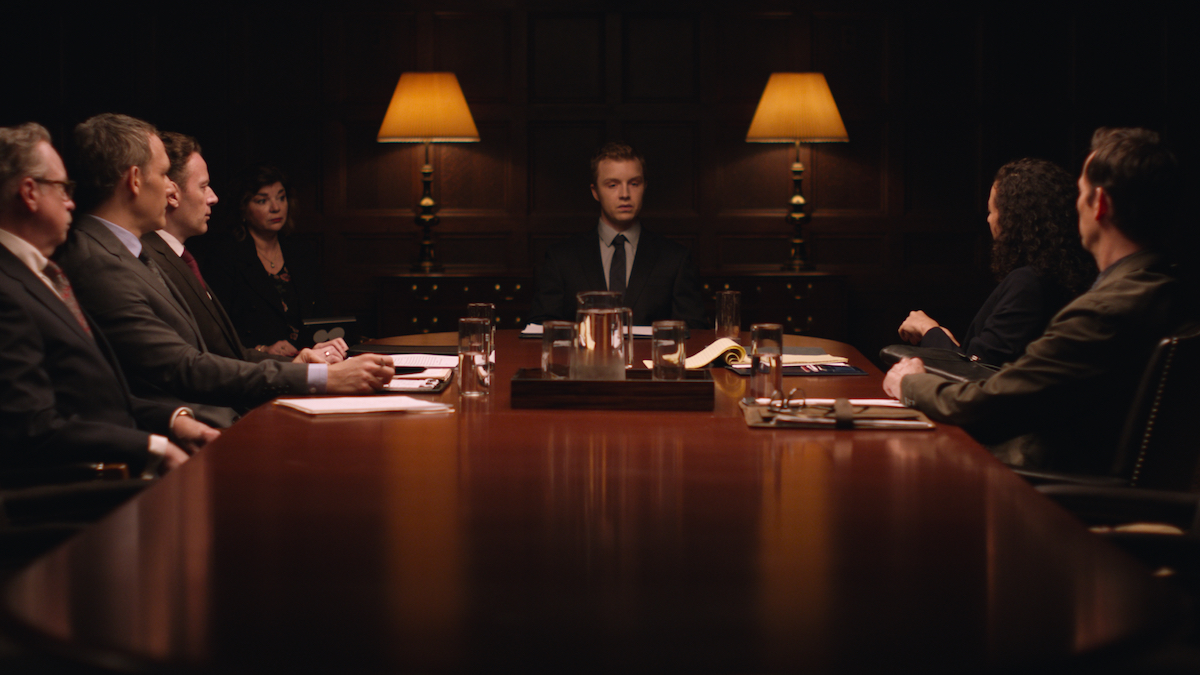
Kelly says that once the characters began to appear in each other’s storylines, “we had to figure out whose scene it was, with the answer being “whoever had the most power.” There are two such moments when Daniel Calder and Paul Evans are at depositions. “In the first, Daniel is more in control, so we shot it using Calder Rules,” Kelly recalls. “The second scene, Daniel loses it, so we shot it handheld and tighter, as we would normally for Paul Evans.”
The deposition scene is a good example of how Kelly, Shelby, and Key Grip Randy Garcia exploited soft top-light in the series. “The location was a room with dark wood–paneled walls in the South Shore Cultural Center, where the Obamas were married,” Kelly smiles.
“We were on the second floor, and because of the trees outside there was no good Condor placement,” she continues. “So we decided to hang a softbox over the large table.”
Rigging Gaffer Dan Gianneschi and Rigging Key Grip Jorge Reyes-Ortiz constructed an aluminum-framed softbox that was 18 inches deep and 4×8 feet long. The box was skinned with Magic Cloth and had an ultra-bounce skirt. Inside the box were two 2×8-inch LiteTiles.
“We had two really long scenes with lots of characters in that space and had to move fast,” Kelly describes. “Randy and his team worked quickly to shape the one overhead source with bounces and negative fill. This ended up being one of my favorite sequences. The actors glowed in the warm, dim top light, and the dark wooden walls fell off into the background beautifully.”
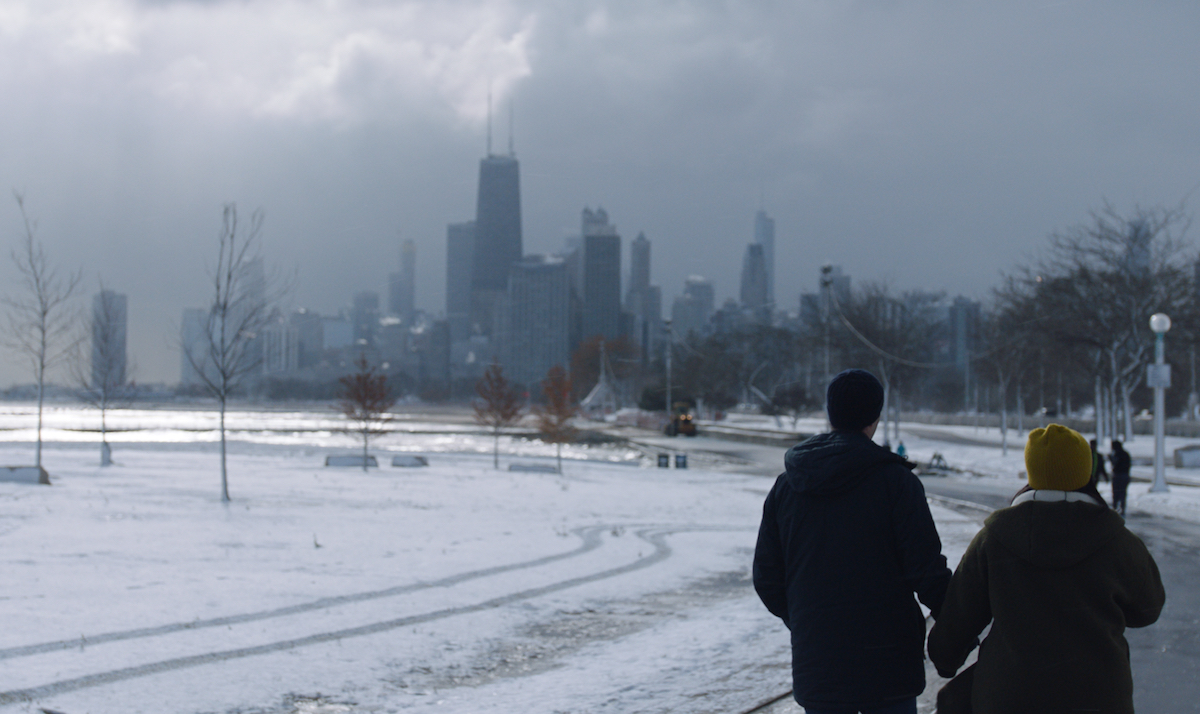
According to Thiele (and the series’ other operators), Episode 108 (the last of the season) “encapsulated all the emotions” of working on The Red Line’s camera team. Directed by Thomas Carter, it combined two additional characters and the show’s most powerful visual element – the constantly moving Red Line train.
“For that, we broke the Calder Rules,” Kelly shares. “Something pivotal happens to Daniel and Jira Calder that finally breaks them out of this static place of grief. The father and daughter take a walk along the coast of Lake Michigan, toward the famous Chicago skyline. The scene was about two pages long. I was concerned about making it Steadicam because there was so much ice on the pavement. However, it didn’t seem to faze Blaine at all.
“We discussed the shot, put down a lot of salt for both Blaine and the cast, and then Blaine proceeded to shoot the most stunning Steadicam shot of the season,” Kelly continues. “The move was perfect and the overcast sky opened up so we could see some beautiful cloud detail and gorgeous glints of morning sunlight on the horizon.”
Carter and Kelly also staged a 50-foot Technocrane move that ties character, city, and train together. “We were on the second day/night split of a large interior scene in the South Loop and wanted to jump outside at night to catch the Red Line train heading into the city on the elevated portion of the tracks,” Kelly remembers. “While we were shooting the last interior scene, we broke off the A-body, allowing [1stAC] Jason [Bonner] to bring it to the waiting crane.”
“As soon as we were built and ready to rehearse, a northbound train was approaching, so we shot it with our phones off the monitor to show Kira and Thomas,” Thiele explains. “The move would be a retraction of the arm from under the tracks to a boom up and extension to safely clear the track structure and power feed while having the train fill the frame on a blind reveal and pull the shot to a wide of the train going into the city.”
“The first rehearsal was with a constrained environment and complicated timing, with [Dolly Grip] Xavier Otten on the arm, [Crane Technician] Brandon Dawkins on the pickle, and Jason pulling focus,” Thiele adds, “and we nailed it! After Kira and Thomas’ approval, we headed back for a few more rehearsals.”
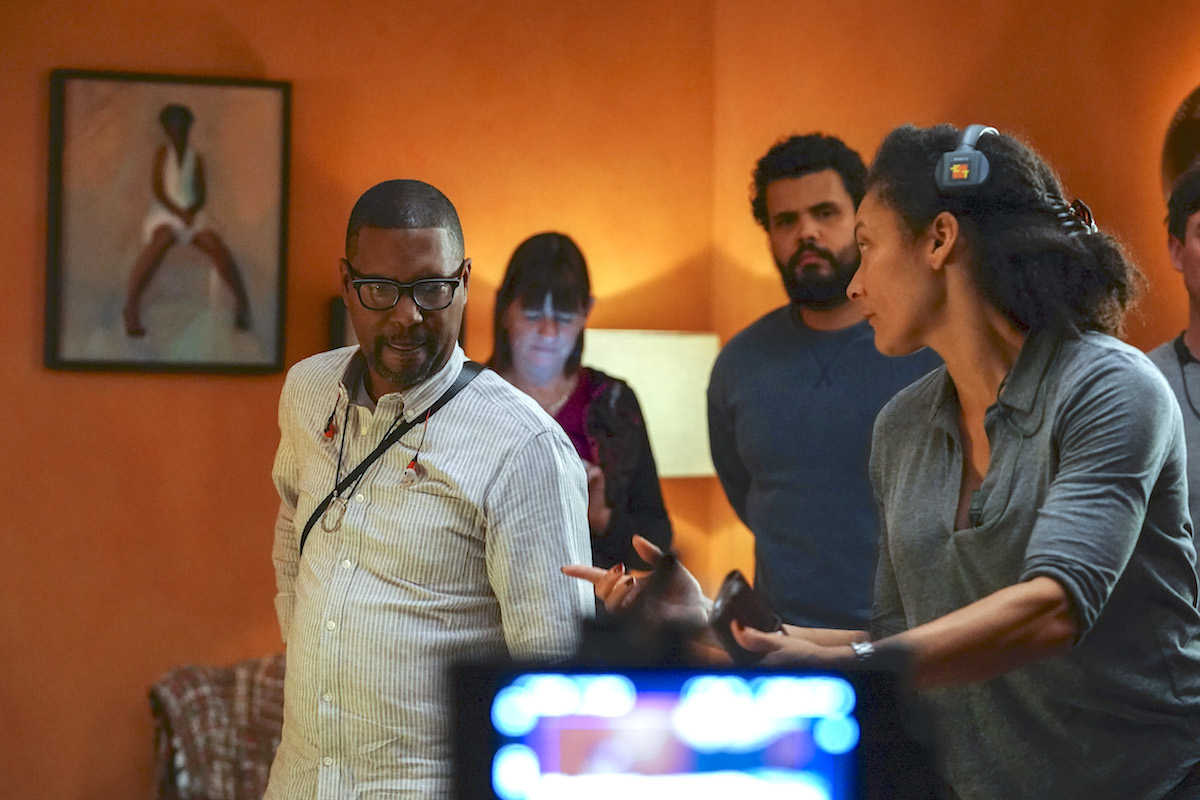
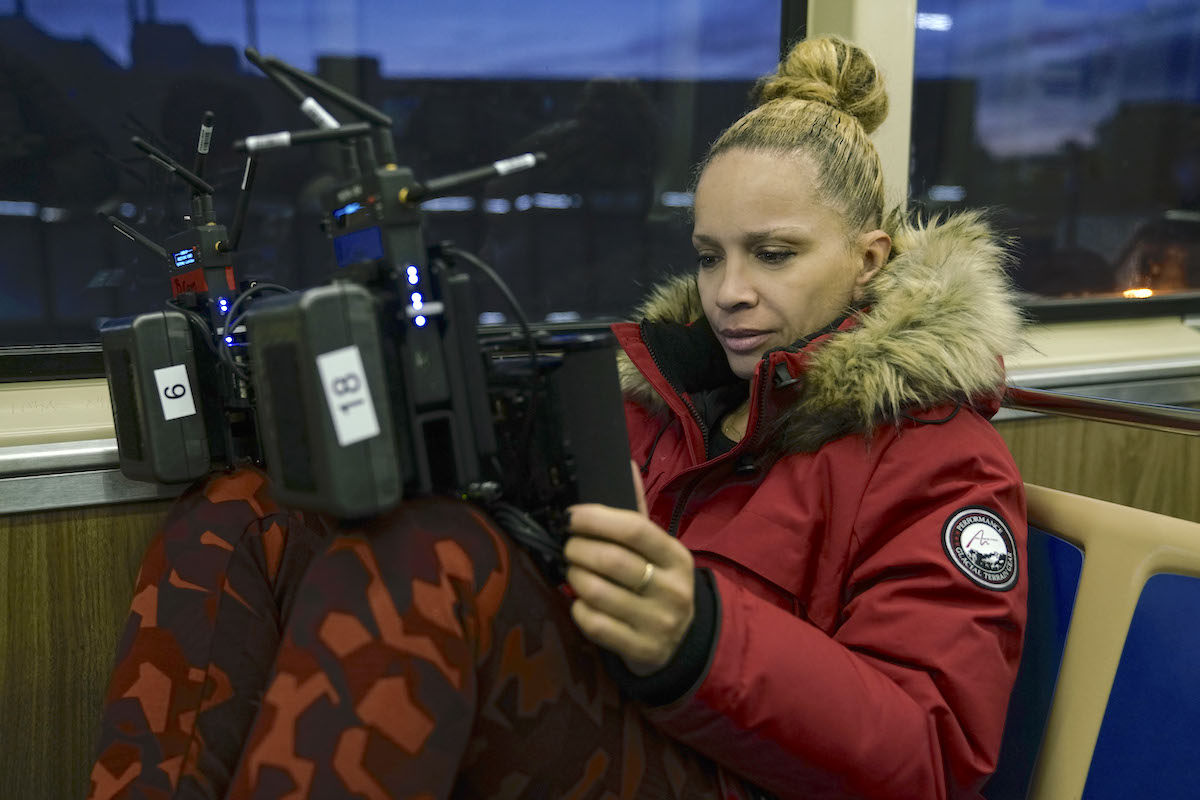
And that’s when things got more complicated. Trains come every 10 to 12 minutes, so Chicago Transit Authority (CTA) liaison Bill Reilly (see sidebar below) was trying to find the best position to see the train emerging from between the buildings and give the crew enough time to get the pace of the head of the shot current and time-out the train crossing.
“We had been approved by the CTA, but we were not in direct communication with or in control of the train movements, so Bill had to eyeball the train’s approach to a signal to best guess its speed,” Thiele adds. “The next two rehearsals we alternated between early and late, in terms of our timing. Then we get the word that we only have three train runs left before the CTA abandons that track for a reroute into the subway. One more rehearsal before the company joins us, and our timing is early again. We’re down to just two chances, and we’ve yet to recreate our very first attempt, and the group of us outside are starting to feel the pressure.”
With only two passes left before the train submerged out of sight, Thiele says that “after Kira got to video village, we rolled and got our best guess as to movement from Bill. We started the crane move, cresting the tracks, just as the second train car filled the frame and pulled our eye to reveal the skyscrapers in the distance. Jason, Xavier, and Brandon all executed the move flawlessly. Everyone was excited that we got the shot and could wrap knowing we made our day. It was an exciting closing moment for The Red Line.”
As Kelly adds: “It’s always a little nerve-wracking to come into a new city and try to crew up. I really couldn’t have been more fortunate to find the camera and lighting crew I had in Chicago. It was beautifully inclusive, inspired by Kevin Hooks and our show creators, Caitlin and Erica, and our other showrunner Sunil. This is an important and timely story and we need to be telling more stories like [The Red Line], which challenge audiences about the levels of gun violence and institutionalized racism we all live with today.
“Working on The Red Line was an experience I’ll never forget,” Kelly concludes. “I love how having the three different shooting styles for each family was so much in service to the narrative. I was constantly asking myself: ‘whose scene is it’? It made every single decision very intentional.”
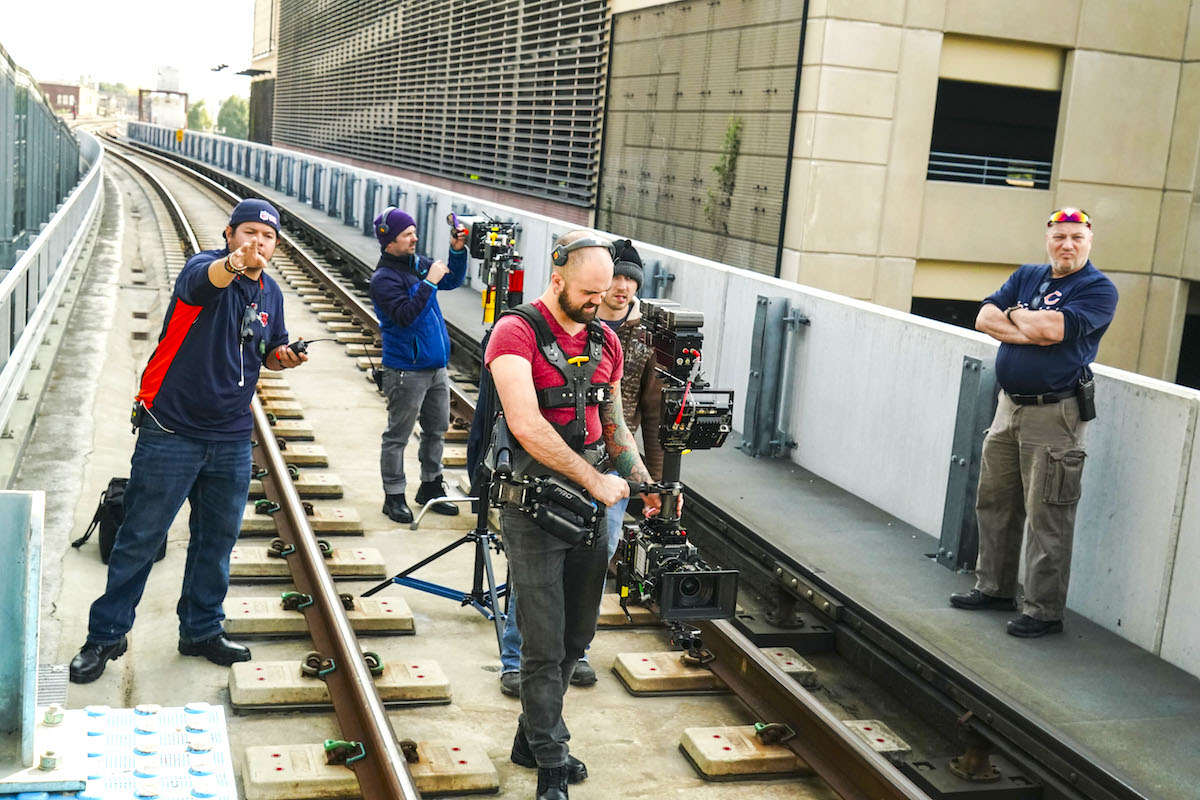
Everything About the Railroad Wants to Kill You
Chicago Transit Authority (and The Red Line) consultant Bill Reilly on making safer sets
“Everything on the railroad wants to kill you, and it’s my job to make sure that doesn’t happen.” That’s exactly how Bill Reilly, a 30-year veteran of the Chicago Transit Authority (CTA) and current consultant on all filming in and around the city’s L-System, including this month’s cover story, The Red Line, starts every scouting, logistics, and safety meeting.
Given the series title, viewers will expect Chicago’s elevated transit system to be a major part of CBS’s new drama. And, in fact, The Red Line is shot on platforms, in trains and on the street. “They also filmed a scene where a woman is knocked to track level and a police officer jumps down to the track to save her,” Reilly describes. “It’s probably the most interesting and involved sequence – because we were actually on the tracks.”
When production notified Reilly about the scene, his first priority was to find a location that could work and a way to get the shot safely. Post tech-scout, Reilly turned his attention to CTA, putting in a request for employees that he knew could handle the workload.
“CTA trains run on 600 volts DC, so the power was removed on that section of track,” Reilly explains. Using a “wiggy” (voltage meter), he then demonstrated to the Red Line production crew that the power was off. He then put a “hold” on the power over the radio. This meant that he would be the only person who could request restoration of power.
“I then measured rail height and clearances at track level so a platform could be built over the rails where we were working,” Reilly adds. “Pads for the fall were placed on the platform and, as a precaution, it further isolated us from the third rail – even though the power was off.”
Access was restricted to being job-specific. “Each one had to have the proper Personal Protective Equipment (PPE), which in this case was proper foot wear, long pants, and a safety vest. Actors were exempt from safety vests, by the way,” Reilly states.
Before anyone who would be going to track level set foot on the location, they had to go through site-specific safety training. They were taught how to walk on the track and step over the rails when needed. “Anyone who could not master the track training procedures or who didn’t bring proper PPE was not allowed on the track,” he adds adamantly.
Reilly placed a CTA Flagman at each end so that no one wandered outside the work zone. The track was removed from service and a stop sign and Portable Track Trip (safety device used to stop trains) was installed. He also had a Rail Service Bulletin describing the work and the out-of-service area issued. The towermen at each end and Rail Supervisors were also given briefings. And the Rail Control Center made periodic announcements over the CTA radios.
The ultimate control of any filmed sequence on the CTA line falls to Reilly. “And in the event that the safety procedures are not followed, filming will come to a halt,” he says. “At this time, the infraction would be evaluated, and I would decide with the CTA if filming would be allowed to continue. A blatant violation will cause the person in question to be escorted from CTA property even if filming is allowed to continue. Sometimes there are bets on how many times I will say, ‘Everything about the railroad wants to kill you,’” he laughs, and then gets serious. “But we really do need these film crews to pay attention.”
Production needs to know how to capture the story, and CTA has to help make it safe. The railroad needs to know when to hold and release commuters, when to open and close the doors, when to move the train, adjust the speed, stop the train, and pull the train back into the starting position. “It’s all about cooperation,” Reilly describes. “Everything about the Railroad wants to kill you, and it is my job to make sure that doesn’t happen.
“See, I did it again!” he laughs. And, yes, Bill, The Red Line crew got the message.
THE RED LINE
Series:
Director of Photography: Kira Kelly
A-Camera Operator: Scott Thiele
A-Camera 1st AC: Jason Bonner
A-Camera 2nd AC: Nina Pillar Portillo
B-Camera Operator/Steadicam: Blaine Baker, SOC
B-Camera 1st AC: Matt Rozek
B-Camera 2nd AC: Matt Feasley
DIT: John Waterman
Loader: Drew Fulton
Digital Utility: Litong Zhen
Still Photographers: Parrish Lewis, Elizabeth Morris
Pilot:
Director of Photography: Manuel Billeter
A-Camera Operator: Scott Thiele
A-Camera 1st AC: Chris Wittenborn
A-Camera 2nd AC: Ron Ruanphae
B-Camera Operator/Steadicam: Sebastian Audinelle
B-Camera 1st AC: Hunter Whalen
B-Camera 2nd AC: Torey Lenart
Digital Utility: Josh Smith
Additional Utility: Mark Irion
Loader: Tom Zimmerman
Still Photographer: Parrish Lewis
